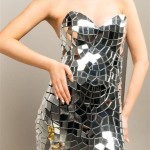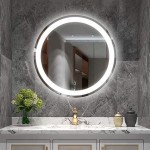Why Do Convex Mirrors Only Produce Virtual Images?
Convex mirrors, characterized by their outward curvature, possess a unique optical property: they exclusively produce virtual images. Understanding this phenomenon requires a closer examination of the behavior of light rays interacting with the mirror's reflective surface and the principles of image formation.
Light rays incident on a convex mirror diverge upon reflection. This divergence is a direct consequence of the mirror's shape. Consider a set of parallel rays approaching the mirror. Because the surface curves outward, the normal line at each point of incidence is angled differently. Applying the law of reflection, which states that the angle of incidence equals the angle of reflection, reveals that the reflected rays spread outwards, never converging in real space.
Image formation in mirrors relies on the perceived intersection of reflected rays. In the case of a convex mirror, the reflected rays diverge. However, if these diverging rays are traced backward, they appear to originate from a single point behind the mirror. This point of apparent origin is the location of the virtual image.
The term "virtual image" signifies that the light rays do not actually converge at the image location. It is an optical illusion created by the brain's interpretation of the diverging rays. A virtual image cannot be projected onto a screen, unlike a real image formed by the convergence of light rays.
The location, size, and orientation of a virtual image formed by a convex mirror can be determined using ray diagrams and the mirror equation. Ray diagrams involve tracing the path of specific incident rays and their corresponding reflected rays. Two commonly used rays are a ray parallel to the principal axis, which reflects as if originating from the focal point, and a ray directed towards the center of curvature, which reflects back along the same path.
The mirror equation, expressed as 1/f = 1/do + 1/di, provides a mathematical relationship between the focal length (f), object distance (do), and image distance (di). For convex mirrors, the focal length is considered negative due to the diverging nature of the reflected rays. The object distance is always positive, while the image distance is negative for virtual images, signifying their location behind the mirror.
Magnification (M) describes the size and orientation of the image relative to the object. It is calculated as M = -di/do. For convex mirrors, the magnification is always positive and less than 1, indicating that the virtual image is always upright and diminished in size compared to the object.
The characteristic of forming only virtual, upright, and diminished images makes convex mirrors suitable for various applications. One prominent use is in vehicle side-view mirrors. The wider field of view provided by the diminished image allows drivers to see a larger portion of the area behind and to the side of the vehicle, enhancing safety. However, the diminished size also creates the perception that objects are farther away than they actually are, a factor drivers must take into account.
Security mirrors in stores and public spaces utilize the same principle. The wide field of view enables surveillance of a larger area, while the convex shape provides a distorted perspective, making it difficult for individuals to judge distances accurately.
In addition to these practical applications, convex mirrors are utilized in optical instruments and scientific research. They are employed in some telescopes to reflect and converge light onto a secondary mirror, and in certain types of interferometers for manipulating light beams.
The exclusive formation of virtual images by convex mirrors is a direct consequence of their diverging reflective properties. This optical behavior, governed by the laws of reflection and geometric principles, results in images that are always upright and diminished. These unique characteristics make convex mirrors invaluable in various applications, from enhancing road safety to facilitating scientific research.
The understanding of how convex mirrors interact with light and form images is crucial in effectively utilizing these mirrors in their diverse applications. The interplay of geometry, reflection, and image formation principles dictates the nature of the virtual images observed. This knowledge allows for proper interpretation of the images formed and informs the design and implementation of optical systems incorporating convex mirrors.
Can A Convex Mirror Produce Real Image When The Object Is Virtual And Vice Versa Concave If Yes How Will It Be Possible Why Quora
Can A Convex Mirror Form Magnified Image Quora

Convex Mirror Image Formation Conditions Ray Diagram Uses
Why Do Convex Mirrors Always Form A Virtual Image Quora

A Virtual Image Is Formed By Concave Mirror When The Object Placedat Focusbetween Focus And Polebetween Centre Of Curvaturebeyond Curvature

Real Image Wikipedia

Difference Between Real Image And Virtual
In What Situations Do Convex Lenses Create Virtual Images Quora
Objects In The Mirror Are Actually Images Article Khan Academy

Fundamental Optics Part 1 Curved Mirrors Circuit Cellar








